
the catalogue #328
| home | catalogue | history | references | appendix |
 |
surfresearch.com.au
the catalogue #328 |
| 1948 Prot Surf Ski, 11 ft 6" |
#328
|

DIMENSIONS
|
Length
:
|
11
|
ft |
6
|
inches | ||
|
Width
:
|
28
|
inches |
Wide
Point :
|
inches | ||
|
Nose
:
|
inches |
Tail
:
|
inches | |||
|
Thickness
:
|
inches |
Pod
:
|
inches | |||
|
Nose
Lift :
|
inches |
Tail
Lift :
|
inches | |||
|
Weight
:
|
kilos |
Volume
:
|
litres | |||
|
Other
:
|
inches |
FEATURES
| Nose:
pin
Tail: pin Deck:
Bottom: .? Rails: square. Rocker: distinct |
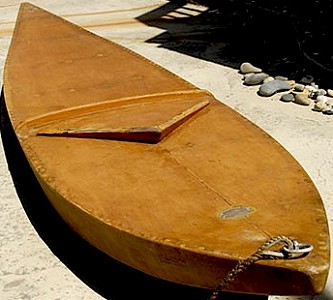 |
| DECOR
DECAL: MARKINGS Deck Metal plate: Specialist in small craft construction. Prot-Craft. Wallace F. Prott (Prop) 65 Parramatta Road, Five Dock, UA 2393. COLOUR Deck Multi panelled plywood deck Bottom Plywood sections. |
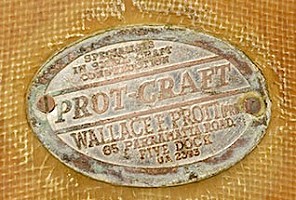 |
| FIN
Timber long base keel. |
 |
 |
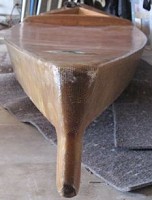 |
I’m an
aussie
living in San Diego, and recently acquired an old
paddleboard/ski or whatever
it is….made in Australia.
The cool
thing
is it has a plate on it identifying the
manufacturer. I’m trying
to find out as much as I can about it. Any info or
leads would be
greatly appreciated.
I’m told
it
dates from the early 1940s and is made of a type of wood
no longer available.
It is
11'6"
by 28” wide, hollow plywood/screw construction with
fiberglass coat.
It has a
brass
plate on the bow that says “Specialist in small
craft design,
"Prot-Craft"
Wallace
F. Prott, 65 Parramatta Road, Five Dock, UA 2393”
The front
part of the deck is convex, and the back is concave.
There is
a
metal bung at the rear.
Thanks
for
your help,
Murray."
MANUFACTURER'S
HISTORY
Researching
Murray's
enquiry, Mr. Wally Prott was contacted by phone at the family
home in Hunter's
Hill NSW in October and November 2007.
The following
notes
are based on the brief phone conversations:
W. F. "Wally"
Prott
started his marine centre, with the assistance of his father,
in 1946 after
returning home from World War Two.
The business
was
located in rental premises at 65 Parramatta Road, Five Dock
before the
puchase a building at 8 Parramatta Road, Croydon.
The company built a range of small recreational craft in timber and plywood including sailboats, dinghies, runabouts, surf skis, surfboards and waterskis and retailed water sports accessories, for example waterski ropes.
Sailboat
models included
the enclosed deck, similiar to the surf ski design, VJ
(Vaucluse Junior),
VS (Vaucluse Senior) and the square nosed Moth, which was
originally a
Melbourne design that first appeared in Sydney in 1948.
With intensive
competition,
these craft were continuously modified to reduce weight (at
the cost of
structual strength), eventually down to 90 lbs (kilos?) - able
to be lifted
by one man.
Other sailboats
included the 14 ft Northbrige Senior and the multi-purpose
Heron.
Plans for the
European
designs such as the Sabot and the OK Dinghy were metric and
built with
a close tolerance, requiring Wally to source metric rulers and
tape-measures.
The OK Dingy
was
the entry level boat for the Olympic Finn class.
Sailboats were
supplied
to the customer as a complete package.
Prot-Craft
built
the masts and spars, the sails were ordered to specification
from established
sailmakers and the rigging from a ship's chandlery supplier.
Larger craft
required
a suitable boat trailer, usually requiring modification of
size and support
bracing to a basic design, also out-sourced.
Smaller craft
(VJs,
Moths and surf skis) could be transported with roof racks.
Prot-Craft
canoes
were built from 8 to 15 feet and, with a range of paddles,
were retailed
by the chain stores Nock'n Kirbys (George Street) and Anthony
Hordens,
Sydney.
| Surf
skis ranged
from a wide 11 foot 6 inch (a recreational model, that
is #328) to a narrow
18'' x 18 feet racing competition design used by the
surf life saving movement.
They were usually fitted with leather or canvas foot straps fixed with screws onto the deck. Apart from the domestic market, Prot-craft surf skis were exported to Lord Howe Island, Honolulu, Saigon, Madagascar, South Africa and Florida. On occassion, rescue skis were ordered by South Sydney Junior Leagues Club for donation to Eastern surburbs surf life saving clubs. Images
right:
Some
timber hollow
surfboards were also manufactured and circa 1957 the
company was supplied
plans for the "new" Hawaiian surfboard, a shorter 9
to 10 feet design with
a fin known in Australia as the Okinuee.
|
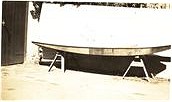

|
Some timber
hollow
surfboards were also manufactured and circa 1957 the company
was supplied
plans for the "new" Hawaiian surfboard, a shorter 9 to 10 feet
design with
a fin known in Australia as the Okinuee.
Around 1960,
the
company updated the surfboard design in balsa wood and
fibreglass.
Early
Prot-Craft
were identified by the screw-on metal plate, shown above.
Wally Prott
recalls
the plate was originally coloured with enamel, a blue
background and red
flash (the raised face?) which appears to worn of the present
example.
These were
followed
by a short-lived die-cast script version, that were pressed
into the timber
with sharpe flanges mounted on the back.
They proved
unsatisfactory,
often detaching from the craft after a short period of use.
By the 1960s,
smaller
items such as canoes and paddles used a cheaper lightweight
molded plastic
screw on identification plate.
Advertising material was generally in the marine section of Wednesday and Saturday editions of the Sydney Morning Herald, in preference to advertising in the current boating magazines of the day which was less productive.
Customers of note included Jack "Gelignite" Murray who often stopped at Prott's marine centre to purchase watersking accessories on his way to Sackville on the upper reaches of the Hawkesbury River and "The Feather King", who arrived in a Bentley to purchase surf skis for use in Saigon.
The comany
ceased
trading circa 1969-1970 as the recreational water craft market
became dominated
by fibreglass and alumimum designs.
The premises
were
sold and then demolished to be converted to a car sales yard.
Wally noted that several years ago, a James Strangelard (Strangeland ?) of Huntington Beach, California made enquiries of a surf ski similar to #328.
Thanks to Wal Prott for his contribution.
DESIGN HISTORY
| The
history of the
development of the surf-ski, a unique Australian
surfcraft design that
has world wide impact, is poorly documented and
largely overlooked by both
surfriding and surf life saving historians.
Critically, it is possible that early models used hollow timber construction prior to the widely promoted designs by American, Tom Blake, who patented his work in 1931 and published detailed plans and construction notes in Modern Mechanix magazine in 1933. Image
right:
|
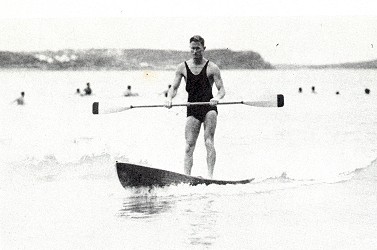 |
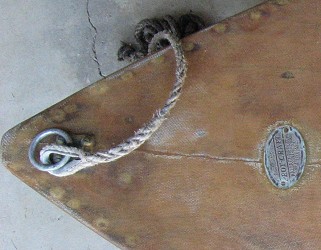
Nose ring, rope and manufacturer's plate. |
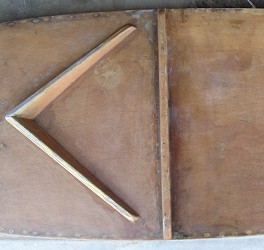
Splash guard and foot brace. |


| home | catalogue | history | references | appendix |